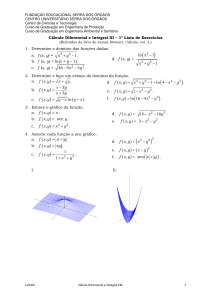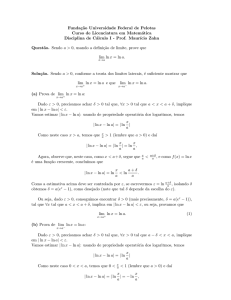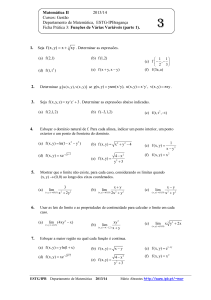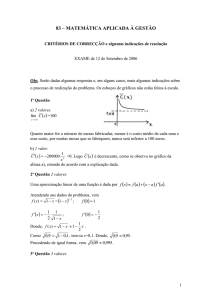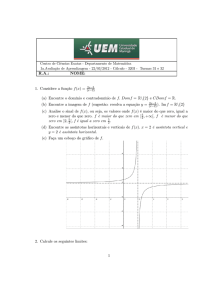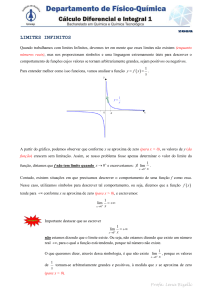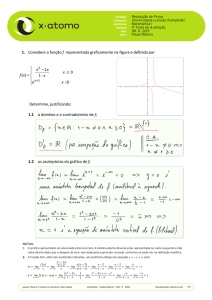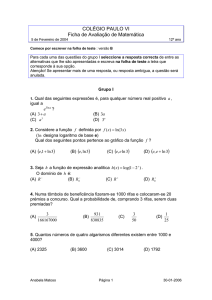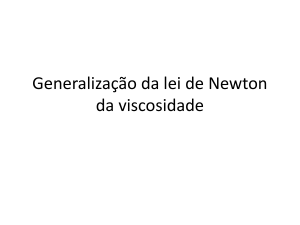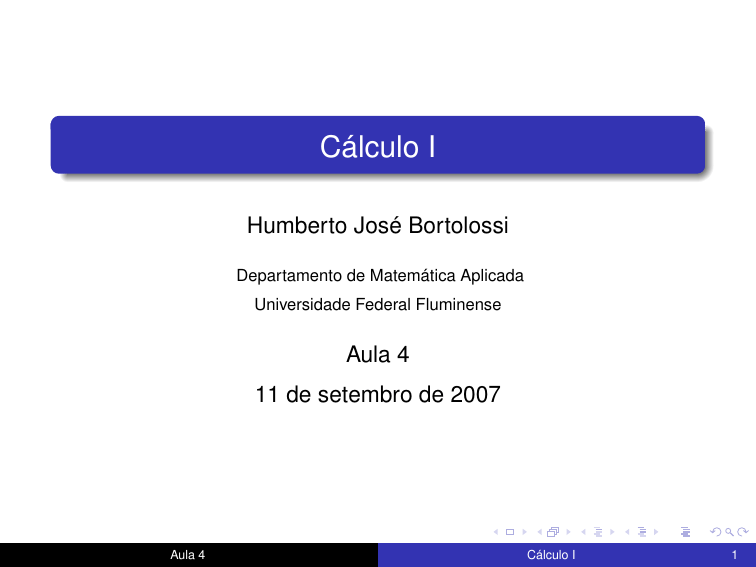
Cálculo I
Humberto José Bortolossi
Departamento de Matemática Aplicada
Universidade Federal Fluminense
Aula 4
11 de setembro de 2007
Aula 4
Cálculo I
1
Exercícios da última aula
Aula 4
Cálculo I
2
Exercício [06] da lista 3
2 x2 + 5 x − 3
x→1/2 2 x 2 − 5 x + 2
lim
(∗)
=
=
=
lim
2 (x − 1/2)(x + 3)
2 (x − 1/2)(x − 2)
lim
x +3
x −2
x→1/2
x→1/2
1/2 + 3
7
= − .
1/2 − 2
3
(∗) pois 2 x 2 + 5 x − 3 = 2 (x − 1/2)(x + 3)
2 x 2 − 5 x + 2 = 2 (x − 1/2)(x − 2).
Aula 4
e
Cálculo I
3
Exercício [06] da lista 3
2 x2 + 5 x − 3
x→1/2 2 x 2 − 5 x + 2
lim
(∗)
=
=
=
lim
2 (x − 1/2)(x + 3)
2 (x − 1/2)(x − 2)
lim
x +3
x −2
x→1/2
x→1/2
1/2 + 3
7
= − .
1/2 − 2
3
(∗) pois 2 x 2 + 5 x − 3 = 2 (x − 1/2)(x + 3)
2 x 2 − 5 x + 2 = 2 (x − 1/2)(x − 2).
Aula 4
e
Cálculo I
4
Exercício [06] da lista 3
2 x2 + 5 x − 3
x→1/2 2 x 2 − 5 x + 2
lim
(∗)
=
=
=
lim
2 (x − 1/2)(x + 3)
2 (x − 1/2)(x − 2)
lim
x +3
x −2
x→1/2
x→1/2
1/2 + 3
7
= − .
1/2 − 2
3
(∗) pois 2 x 2 + 5 x − 3 = 2 (x − 1/2)(x + 3)
2 x 2 − 5 x + 2 = 2 (x − 1/2)(x − 2).
Aula 4
e
Cálculo I
5
Exercício [06] da lista 3
2 x2 + 5 x − 3
x→1/2 2 x 2 − 5 x + 2
lim
(∗)
=
=
=
lim
2 (x − 1/2)(x + 3)
2 (x − 1/2)(x − 2)
lim
x +3
x −2
x→1/2
x→1/2
1/2 + 3
7
= − .
1/2 − 2
3
(∗) pois 2 x 2 + 5 x − 3 = 2 (x − 1/2)(x + 3)
2 x 2 − 5 x + 2 = 2 (x − 1/2)(x − 2).
Aula 4
e
Cálculo I
6
Exercício [06] da lista 3
2 x2 + 5 x − 3
x→1/2 2 x 2 − 5 x + 2
lim
(∗)
=
=
=
lim
2 (x − 1/2)(x + 3)
2 (x − 1/2)(x − 2)
lim
x +3
x −2
x→1/2
x→1/2
1/2 + 3
7
= − .
1/2 − 2
3
(∗) pois 2 x 2 + 5 x − 3 = 2 (x − 1/2)(x + 3)
2 x 2 − 5 x + 2 = 2 (x − 1/2)(x − 2).
Aula 4
e
Cálculo I
7
Exercício [09] da lista 3
√
lim
x +2+
√
√
6−
√
2
=
x→0
x +6−
x
√
lim
√
2
√
+
x +6−
x
√ !
6
=
x→0
x +2−
x
√
2
√
√ √
√ !
√
2
x +6− 6
x +6+ 6
√
√
·√
+
·√
x
x +6+ 6
x +2+ 2
√
x +2+
=
lim
x→0
x +2−
x
lim
x→0
!
√
√
√
√
( x + 2)2 − ( 2)2 ( x + 6)2 − ( 6)2
√ +
√
√
√
x · ( x + 6 + 6)
x · ( x + 2 + 2)
=
√
lim
x→0
Aula 4
x
x
√ +
√
√
√
x · ( x + 2 + 2) x · ( x + 6 + 6)
Cálculo I
8
Exercício [09] da lista 3
√
lim
x +2+
√
√
6−
√
2
=
x→0
x +6−
x
√
lim
√
2
√
+
x +6−
x
√ !
6
=
x→0
x +2−
x
√
2
√
√ √
√ !
√
2
x +6− 6
x +6+ 6
√
√
·√
+
·√
x
x +6+ 6
x +2+ 2
√
x +2+
=
lim
x→0
x +2−
x
lim
x→0
!
√
√
√
√
( x + 2)2 − ( 2)2 ( x + 6)2 − ( 6)2
√ +
√
√
√
x · ( x + 6 + 6)
x · ( x + 2 + 2)
=
√
lim
x→0
Aula 4
x
x
√ +
√
√
√
x · ( x + 2 + 2) x · ( x + 6 + 6)
Cálculo I
9
Exercício [09] da lista 3
√
lim
x +2+
√
√
6−
√
2
=
x→0
x +6−
x
√
lim
√
2
√
+
x +6−
x
√ !
6
=
x→0
x +2−
x
√
2
√
√ √
√ !
√
2
x +6− 6
x +6+ 6
√
√
·√
+
·√
x
x +6+ 6
x +2+ 2
√
x +2+
=
lim
x→0
x +2−
x
lim
x→0
!
√
√
√
√
( x + 2)2 − ( 2)2 ( x + 6)2 − ( 6)2
√ +
√
√
√
x · ( x + 6 + 6)
x · ( x + 2 + 2)
=
√
lim
x→0
Aula 4
x
x
√ +
√
√
√
x · ( x + 2 + 2) x · ( x + 6 + 6)
Cálculo I
10
Exercício [09] da lista 3
√
lim
x +2+
√
√
6−
√
2
=
x→0
x +6−
x
√
lim
√
2
√
+
x +6−
x
√ !
6
=
x→0
x +2−
x
√
2
√
√ √
√ !
√
2
x +6− 6
x +6+ 6
√
√
·√
+
·√
x
x +6+ 6
x +2+ 2
√
x +2+
=
lim
x→0
x +2−
x
lim
x→0
!
√
√
√
√
( x + 2)2 − ( 2)2 ( x + 6)2 − ( 6)2
√ +
√
√
√
x · ( x + 6 + 6)
x · ( x + 2 + 2)
=
√
lim
x→0
Aula 4
x
x
√ +
√
√
√
x · ( x + 2 + 2) x · ( x + 6 + 6)
Cálculo I
11
Exercício [09] da lista 3
√
lim
x +2+
√
√
6−
√
2
=
x→0
x +6−
x
√
lim
√
2
√
+
x +6−
x
√ !
6
=
x→0
x +2−
x
√
2
√
√ √
√ !
√
2
x +6− 6
x +6+ 6
√
√
·√
+
·√
x
x +6+ 6
x +2+ 2
√
x +2+
=
lim
x→0
x +2−
x
lim
x→0
!
√
√
√
√
( x + 2)2 − ( 2)2 ( x + 6)2 − ( 6)2
√ +
√
√
√
x · ( x + 6 + 6)
x · ( x + 2 + 2)
=
√
lim
x→0
Aula 4
x
x
√ +
√
√
√
x · ( x + 2 + 2) x · ( x + 6 + 6)
Cálculo I
12
Exercício [09] da lista 3
Desta maneira,
√
lim
x→0
x +2+
√
x +6−
x
Aula 4
√
6−
√
2
x
x
√ +
√
√
√
x→0 x · ( x + 2 + 2)
x · ( x + 6 + 6)
1
1
√ +√
√
= lim √
x→0
x +6+ 6
x +2+ 2
√
√
1
1
6+ 2
√ + √ =
√
=
.
4 3
2 2 2 6
=
lim
Cálculo I
13
Exercício [09] da lista 3
Desta maneira,
√
lim
x→0
x +2+
√
x +6−
x
Aula 4
√
6−
√
2
x
x
√ +
√
√
√
x→0 x · ( x + 2 + 2)
x · ( x + 6 + 6)
1
1
√ +√
√
= lim √
x→0
x +6+ 6
x +2+ 2
√
√
1
1
6+ 2
√ + √ =
√
=
.
4 3
2 2 2 6
=
lim
Cálculo I
14
Exercício [09] da lista 3
Desta maneira,
√
lim
x→0
x +2+
√
x +6−
x
Aula 4
√
6−
√
2
x
x
√ +
√
√
√
x→0 x · ( x + 2 + 2)
x · ( x + 6 + 6)
1
1
√ +√
√
= lim √
x→0
x +6+ 6
x +2+ 2
√
√
1
1
6+ 2
√ + √ =
√
=
.
4 3
2 2 2 6
=
lim
Cálculo I
15
Exercício [09] da lista 3
Desta maneira,
√
lim
x→0
x +2+
√
x +6−
x
Aula 4
√
6−
√
2
x
x
√ +
√
√
√
x→0 x · ( x + 2 + 2)
x · ( x + 6 + 6)
1
1
√ +√
√
= lim √
x→0
x +6+ 6
x +2+ 2
√
√
1
1
6+ 2
√ + √ =
√
=
.
4 3
2 2 2 6
=
lim
Cálculo I
16
Exercício [11] da lista 3
Como x 2 − 5 x + 4 = (x − 1)(x − 4), segue-se que
x2 − 5 x + 4
(x − 1)(x − 4)
= lim
.
|x − 1|
|x − 1|
x→1
x→1
lim
Assim, precisamos estudar os limites laterais
lim+
x→1
(x − 1)(x − 4)
|x − 1|
Aula 4
e
lim
x→1−
(x − 1)(x − 4)
.
|x − 1|
Cálculo I
17
Exercício [11] da lista 3
Como x 2 − 5 x + 4 = (x − 1)(x − 4), segue-se que
(x − 1)(x − 4)
x2 − 5 x + 4
= lim
.
|x − 1|
|x − 1|
x→1
x→1
lim
Assim, precisamos estudar os limites laterais
lim+
x→1
(x − 1)(x − 4)
|x − 1|
Aula 4
e
lim
x→1−
(x − 1)(x − 4)
.
|x − 1|
Cálculo I
18
Exercício [11] da lista 3
Como x 2 − 5 x + 4 = (x − 1)(x − 4), segue-se que
(x − 1)(x − 4)
x2 − 5 x + 4
= lim
.
|x − 1|
|x − 1|
x→1
x→1
lim
Assim, precisamos estudar os limites laterais
lim+
x→1
(x − 1)(x − 4)
|x − 1|
Aula 4
e
lim
x→1−
(x − 1)(x − 4)
.
|x − 1|
Cálculo I
19
Exercício [11] da lista 3
Agora,
lim
x→1+
(x − 1)(x − 4)
(x − 1)(x − 4)
= lim+
= lim+ (x − 4) = −3
|x − 1|
x −1
x→1
x→1
e
lim
x→1−
(x − 1)(x − 4)
(x − 1)(x − 4)
= lim
= lim −(x − 4) = +3.
|x − 1|
−(x − 1)
x→1−
x→1−
Aula 4
Cálculo I
20
Exercício [11] da lista 3
Agora,
lim
x→1+
(x − 1)(x − 4)
(x − 1)(x − 4)
= lim+
= lim+ (x − 4) = −3
|x − 1|
x −1
x→1
x→1
e
lim
x→1−
(x − 1)(x − 4)
(x − 1)(x − 4)
= lim
= lim −(x − 4) = +3.
|x − 1|
−(x − 1)
x→1−
x→1−
Aula 4
Cálculo I
21
Exercício [11] da lista 3
Agora,
lim
x→1+
(x − 1)(x − 4)
(x − 1)(x − 4)
= lim+
= lim+ (x − 4) = −3
|x − 1|
x −1
x→1
x→1
e
lim
x→1−
(x − 1)(x − 4)
(x − 1)(x − 4)
= lim
= lim −(x − 4) = +3.
|x − 1|
−(x − 1)
x→1−
x→1−
Aula 4
Cálculo I
22
Exercício [11] da lista 3
Agora,
lim
x→1+
(x − 1)(x − 4)
(x − 1)(x − 4)
= lim+
= lim+ (x − 4) = −3
|x − 1|
x −1
x→1
x→1
e
lim
x→1−
(x − 1)(x − 4)
(x − 1)(x − 4)
= lim
= lim −(x − 4) = +3.
|x − 1|
−(x − 1)
x→1−
x→1−
Aula 4
Cálculo I
23
Exercício [11] da lista 3
Agora,
lim
x→1+
(x − 1)(x − 4)
(x − 1)(x − 4)
= lim+
= lim+ (x − 4) = −3
|x − 1|
x −1
x→1
x→1
e
lim
x→1−
(x − 1)(x − 4)
(x − 1)(x − 4)
= lim
= lim −(x − 4) = +3.
|x − 1|
−(x − 1)
x→1−
x→1−
Aula 4
Cálculo I
24
Exercício [11] da lista 3
Agora,
lim
x→1+
(x − 1)(x − 4)
(x − 1)(x − 4)
= lim+
= lim+ (x − 4) = −3
|x − 1|
x −1
x→1
x→1
e
lim
x→1−
(x − 1)(x − 4)
(x − 1)(x − 4)
= lim
= lim −(x − 4) = +3.
|x − 1|
−(x − 1)
x→1−
x→1−
Aula 4
Cálculo I
25
Exercício [11] da lista 3
Agora,
lim
x→1+
(x − 1)(x − 4)
(x − 1)(x − 4)
= lim+
= lim+ (x − 4) = −3
|x − 1|
x −1
x→1
x→1
e
lim
x→1−
(x − 1)(x − 4)
(x − 1)(x − 4)
= lim
= lim −(x − 4) = +3.
|x − 1|
−(x − 1)
x→1−
x→1−
Aula 4
Cálculo I
26
Exercício [11] da lista 3
Como
lim+
x→1
(x − 1)(x − 4)
(x − 1)(x − 4)
= −3 6= +3 = lim
,
−
|x − 1|
|x − 1|
x→1
segue-se que
x2 − 5 x + 4
!
|x − 1|
x→1
não existe lim
Aula 4
Cálculo I
27
Exercício [11] da lista 3
Como
lim+
x→1
(x − 1)(x − 4)
(x − 1)(x − 4)
= −3 6= +3 = lim
,
−
|x − 1|
|x − 1|
x→1
segue-se que
x2 − 5 x + 4
!
|x − 1|
x→1
não existe lim
Aula 4
Cálculo I
28
Propriedades de limites
Aula 4
Cálculo I
29
Propriedades de limites
Proposição
Suponha que existam os limites lim f (x) e lim g(x). Então:
x→p
x→p
(1) O limite de uma soma é a soma dos limites:
lim (f (x) + g(x)) = lim f (x) + lim g(x).
x→p
x→p
x→p
(2) O limite de uma diferença é a diferença dos limites:
lim (f (x) − g(x)) = lim f (x) − lim g(x).
x→p
x→p
x→p
(3) O limite de um produto é o produto dos limites:
lim (f (x) · g(x)) = lim f (x) · lim g(x).
x→p
Aula 4
x→p
x→p
Cálculo I
30
Propriedades de limites
Proposição
(4) O limite de um quociente é o quociente dos limites, desde
que o limite do denominador seja diferente de zero:
lim f (x)
f (x)
x→p
=
.
x→p g(x)
lim g(x)
lim
x→p
(5) O limite de uma constante vezes uma função é igual a
constante vezes o limite da função:
lim (c · f(x)) = c · lim f (x).
x→p
Aula 4
x→p
Cálculo I
31
Propriedades de limites
Corolário
Suponha que exista o limite lim f (x). Então, para todo numero
x→p
inteiro n > 0, vale que
n
lim [f (x)] = lim f (x) .
n
x→p
x→p
Demonstração:
lim [f (x)]n = lim (f (x) · f (x) · · · f (x))
(por (3))
x→p
=
lim f (x) · lim f (x) · · · lim f (x)
x→p
x→p
x→p
n
= lim f (x) .
x→p
x→p
Aula 4
Cálculo I
32
Propriedades de limites
Corolário
Suponha que exista o limite lim f (x). Então, para todo numero
x→p
inteiro n > 0, vale que
n
lim [f (x)] = lim f (x) .
n
x→p
x→p
Demonstração:
lim [f (x)]n = lim (f (x) · f (x) · · · f (x))
(por (3))
x→p
=
lim f (x) · lim f (x) · · · lim f (x)
x→p
x→p
x→p
n
= lim f (x) .
x→p
x→p
Aula 4
Cálculo I
33
Propriedades de limites
Os resultados anteriores
continuam válidos para limites laterais!
Aula 4
Cálculo I
34
Exemplo
lim (2 x 2 − 3 x + 4) = lim (2 x 2 ) − lim (3 x) + lim 4
x→5
x→5
x→5
x→5
= 2 lim x 2 − 3 lim x + lim 4
x→5
x→5
x→5
= 2 (5)2 − 3 (5) + 4 = 39.
Aula 4
Cálculo I
35
Exemplo
lim (2 x 2 − 3 x + 4) = lim (2 x 2 ) − lim (3 x) + lim 4
x→5
x→5
x→5
x→5
= 2 lim x 2 − 3 lim x + lim 4
x→5
x→5
x→5
= 2 (5)2 − 3 (5) + 4 = 39.
Aula 4
Cálculo I
36
Exemplo
lim (2 x 2 − 3 x + 4) = lim (2 x 2 ) − lim (3 x) + lim 4
x→5
x→5
x→5
x→5
= 2 lim x 2 − 3 lim x + lim 4
x→5
x→5
x→5
= 2 (5)2 − 3 (5) + 4 = 39.
Aula 4
Cálculo I
37
Exemplo
lim (2 x 2 − 3 x + 4) = lim (2 x 2 ) − lim (3 x) + lim 4
x→5
x→5
x→5
x→5
= 2 lim x 2 − 3 lim x + lim 4
x→5
x→5
x→5
= 2 (5)2 − 3 (5) + 4 = 39.
Aula 4
Cálculo I
38
Exemplo
lim (2 x 2 − 3 x + 4) = lim (2 x 2 ) − lim (3 x) + lim 4
x→5
x→5
x→5
x→5
= 2 lim x 2 − 3 lim x + lim 4
x→5
x→5
x→5
= 2 (5)2 − 3 (5) + 4 = 39.
Aula 4
Cálculo I
39
Exemplo
x3 + 2 x2 − 1
lim
=
5 − 3x
x→−2
lim (x 3 + 2 x 2 − 1)
x→−2
lim (5 − 3 x)
x→−2
lim x 3 + 2 lim x 2 − lim 1
=
x→−2
x→−2
x→−2
=
Aula 4
x→−2
lim 5 − 3 lim x
x→−2
(−2)3 + 2 (−2)2 − 1
1
= − .
5 − 3 (−2)
11
Cálculo I
40
Exemplo
x3 + 2 x2 − 1
=
lim
5 − 3x
x→−2
lim (x 3 + 2 x 2 − 1)
x→−2
lim (5 − 3 x)
x→−2
lim x 3 + 2 lim x 2 − lim 1
=
x→−2
x→−2
x→−2
=
Aula 4
x→−2
lim 5 − 3 lim x
x→−2
(−2)3 + 2 (−2)2 − 1
1
= − .
5 − 3 (−2)
11
Cálculo I
41
Exemplo
x3 + 2 x2 − 1
=
lim
5 − 3x
x→−2
lim (x 3 + 2 x 2 − 1)
x→−2
lim (5 − 3 x)
x→−2
lim x 3 + 2 lim x 2 − lim 1
=
x→−2
x→−2
x→−2
=
Aula 4
x→−2
lim 5 − 3 lim x
x→−2
(−2)3 + 2 (−2)2 − 1
1
= − .
5 − 3 (−2)
11
Cálculo I
42
Exemplo
x3 + 2 x2 − 1
=
lim
5 − 3x
x→−2
lim (x 3 + 2 x 2 − 1)
x→−2
lim (5 − 3 x)
x→−2
lim x 3 + 2 lim x 2 − lim 1
=
x→−2
x→−2
x→−2
=
Aula 4
x→−2
lim 5 − 3 lim x
x→−2
(−2)3 + 2 (−2)2 − 1
1
= − .
5 − 3 (−2)
11
Cálculo I
43
Exemplo
x3 + 2 x2 − 1
=
lim
5 − 3x
x→−2
lim (x 3 + 2 x 2 − 1)
x→−2
lim (5 − 3 x)
x→−2
lim x 3 + 2 lim x 2 − lim 1
=
x→−2
x→−2
x→−2
=
Aula 4
x→−2
lim 5 − 3 lim x
x→−2
(−2)3 + 2 (−2)2 − 1
1
= − .
5 − 3 (−2)
11
Cálculo I
44
Exemplo
lim [f (x) + 5 g(x)] = lim f (x) + 5 lim g(x) = 1 + 5 (−1) = −4.
x→−2
Aula 4
x→−2
x→−2
Cálculo I
45
Exemplo
lim [f (x) + 5 g(x)] = lim f (x) + 5 lim g(x) = 1 + 5 (−1) = −4.
x→−2
Aula 4
x→−2
x→−2
Cálculo I
46
Exemplo
lim [f (x) + 5 g(x)] = lim f (x) + 5 lim g(x) = 1 + 5 (−1) = −4.
x→−2
Aula 4
x→−2
x→−2
Cálculo I
47
Exemplo
lim [f (x) · g(x)] não existe!
x→1
Aula 4
Cálculo I
48
Exemplo
lim [f (x) · g(x)] não existe!
x→1
Aula 4
Cálculo I
49
Exemplo
pois lim [f (x) · g(x)] = lim f (x) · lim g(x) = (2)(−2) = −4 6= − 2 = (2)(−1) = lim+ [f (x) · g(x)].
x→1−
x→1−
Aula 4
x→1−
x→1
Cálculo I
50
Exemplo
pois lim [f (x) · g(x)] = lim f (x) · lim g(x) = (2)(−2) = −4 6= − 2 = (2)(−1) = lim+ [f (x) · g(x)].
x→1−
x→1−
Aula 4
x→1−
x→1
Cálculo I
51
Exemplo
pois lim [f (x) · g(x)] = lim f (x) · lim g(x) = (2)(−2) = −4 6= − 2 = (2)(−1) = lim+ [f (x) · g(x)].
x→1−
x→1−
Aula 4
x→1−
x→1
Cálculo I
52
Exemplo
pois lim [f (x) · g(x)] = lim f (x) · lim g(x) = (2)(−2) = −4 6= − 2 = (2)(−1) = lim+ [f (x) · g(x)].
x→1−
x→1−
Aula 4
x→1−
x→1
Cálculo I
53
Exemplo
pois lim [f (x) · g(x)] = lim f (x) · lim g(x) = (2)(−2) = −4 6= − 2 = (2)(−1) = lim+ [f (x) · g(x)].
x→1−
x→1−
Aula 4
x→1−
x→1
Cálculo I
54
Exemplo
pois lim [f (x) · g(x)] = lim f (x) · lim g(x) = (2)(−2) = −4 6= − 2 = (2)(−1) = lim+ [f (x) · g(x)].
x→1−
x→1−
Aula 4
x→1−
x→1
Cálculo I
55
Exemplo
pois lim [f (x) · g(x)] = lim f (x) · lim g(x) = (2)(−2) = −4 6= − 2 = (2)(−1) = lim+ [f (x) · g(x)].
x→1−
x→1−
Aula 4
x→1−
x→1
Cálculo I
56
Exemplo
lim (g(x)/f (x)) =
x→2
Aula 4
lim g(x) / lim f (x) = 0/2 = 0.
x→2
x→2
Cálculo I
57
Exemplo
lim (g(x)/f (x)) =
x→2
Aula 4
lim g(x) / lim f (x) = 0/2 = 0.
x→2
x→2
Cálculo I
58
Exemplo
lim (g(x)/f (x)) =
x→2
Aula 4
lim g(x) / lim f (x) = 0/2 = 0.
x→2
x→2
Cálculo I
59
O teorema do confronto
Aula 4
Cálculo I
60
O teorema do confronto
Teorema
Se f (x) ≤ g(x) ≤ h(x) quando x está próximo de p (exceto
possivelmente em p) e
lim f (x) = L = lim h(x),
x→p
x→p
então
lim g(x) = L.
x→p
Este teorema também é conhecido como
o teorema do sanduíche.
Aula 4
Cálculo I
61
O teorema do confronto
Teorema
Se f (x) ≤ g(x) ≤ h(x) quando x está próximo de p (exceto
possivelmente em p) e
lim f (x) = L = lim h(x),
x→p
x→p
então
lim g(x) = L.
x→p
Este teorema também é conhecido como
o teorema do sanduíche.
Aula 4
Cálculo I
62
Exemplo
1
Mostre que lim x sen
= 0.
x
x→0
2
Solução. Temos que para todo x 6= 0, −1 ≤ sen(1/x) ≤ +1. Logo, para todo
x 6= 0,
1
≤ +x 2
−x 2 ≤ x 2 sen
x
|{z} |
{z
} |{z}
f (x)
g(x)
h(x)
Como limx→0 (−x)2 = 0 = limx→0 (+x 2 ), segue pelo teorema do confronto
que
1
2
lim x sen
= 0.
x
x→0
Aula 4
Cálculo I
63
Exemplo
1
Mostre que lim x sen
= 0.
x
x→0
2
Solução. Temos que para todo x 6= 0, −1 ≤ sen(1/x) ≤ +1. Logo, para todo
x 6= 0,
1
≤ +x 2
−x 2 ≤ x 2 sen
x
|{z} |
{z
} |{z}
f (x)
g(x)
h(x)
Como limx→0 (−x)2 = 0 = limx→0 (+x 2 ), segue pelo teorema do confronto
que
1
2
lim x sen
= 0.
x
x→0
Aula 4
Cálculo I
64
Exemplo
1
Mostre que lim x sen
= 0.
x
x→0
2
Solução. Temos que para todo x 6= 0, −1 ≤ sen(1/x) ≤ +1. Logo, para todo
x 6= 0,
1
≤ +x 2
−x 2 ≤ x 2 sen
x
|{z} |
{z
} |{z}
f (x)
g(x)
h(x)
Como limx→0 (−x)2 = 0 = limx→0 (+x 2 ), segue pelo teorema do confronto
que
1
2
lim x sen
= 0.
x
x→0
Aula 4
Cálculo I
65
Exemplo
1
Mostre que lim x sen
= 0.
x
x→0
2
Solução. Temos que para todo x 6= 0, −1 ≤ sen(1/x) ≤ +1. Logo, para todo
x 6= 0,
1
−x 2 ≤ x 2 sen
≤ +x 2
x
|{z} |
{z
} |{z}
f (x)
g(x)
h(x)
Como limx→0 (−x)2 = 0 = limx→0 (+x 2 ), segue pelo teorema do confronto
que
1
2
lim x sen
= 0.
x
x→0
Aula 4
Cálculo I
66
Exemplo
1
Mostre que lim x sen
= 0.
x
x→0
2
Solução. Temos que para todo x 6= 0, −1 ≤ sen(1/x) ≤ +1. Logo, para todo
x 6= 0,
1
≤ +x 2
−x 2 ≤ x 2 sen
x
|{z} |
{z
} |{z}
f (x)
g(x)
h(x)
Como limx→0 (−x)2 = 0 = limx→0 (+x 2 ), segue pelo teorema do confronto
que
1
2
lim x sen
= 0.
x
x→0
Aula 4
Cálculo I
67
Exemplo
1
Mostre que lim x sen
= 0.
x
x→0
2
Solução. Temos que para todo x 6= 0, −1 ≤ sen(1/x) ≤ +1. Logo, para todo
x 6= 0,
1
≤ +x 2
−x 2 ≤ x 2 sen
x
|{z} |
{z
} |{z}
f (x)
g(x)
h(x)
Como limx→0 (−x)2 = 0 = limx→0 (+x 2 ), segue pelo teorema do confronto
que
1
2
lim x sen
= 0.
x
x→0
Aula 4
Cálculo I
68
Exemplo
1
Mostre que lim x sen
= 0.
x
x→0
2
Solução. Temos que para todo x 6= 0, −1 ≤ sen(1/x) ≤ +1. Logo, para todo
x 6= 0,
1
≤ +x 2
−x 2 ≤ x 2 sen
x
|{z} |
{z
} |{z}
f (x)
g(x)
h(x)
Como limx→0 (−x)2 = 0 = limx→0 (+x 2 ), segue pelo teorema do confronto
que
1
2
lim x sen
= 0.
x
x→0
Aula 4
Cálculo I
69
Exemplo
Aula 4
Cálculo I
70
Verdadeiro ou falso?
Se f (x) ≤ g(x) ≤ h(x) quando x está próximo de p (exceto
possivelmente em p) e
lim f (x) = L
e
x→p
lim h(x) = M,
x→p
então
lim g(x) existe.
x→p
Falso!
1
∀x =
6 0, −1 ≤ sen
≤ +1 ,
x
|{z} | {z } |{z}
f (x)
g(x)
mas
Aula 4
lim f (x) = L = −1,
lim h(x) = M = +1,
x→0
x→0
h(x)
lim g(x) = lim sen
x→0
x→0
1
não existe!
x
Cálculo I
71
Verdadeiro ou falso?
Se f (x) ≤ g(x) ≤ h(x) quando x está próximo de p (exceto
possivelmente em p) e
lim f (x) = L
e
x→p
lim h(x) = M,
x→p
então
lim g(x) existe.
x→p
Falso!
1
∀x =
6 0, −1 ≤ sen
≤ +1 ,
x
|{z} | {z } |{z}
f (x)
g(x)
mas
Aula 4
lim f (x) = L = −1,
lim h(x) = M = +1,
x→0
x→0
h(x)
lim g(x) = lim sen
x→0
x→0
1
não existe!
x
Cálculo I
72
Verdadeiro ou falso?
Se f (x) ≤ g(x) ≤ h(x) quando x está próximo de p (exceto
possivelmente em p) e
lim f (x) = L
e
x→p
lim h(x) = M,
x→p
então
lim g(x) existe.
x→p
Falso!
1
∀x =
6 0, −1 ≤ sen
≤ +1 ,
x
|{z} | {z } |{z}
f (x)
g(x)
mas
Aula 4
lim f (x) = L = −1,
lim h(x) = M = +1,
x→0
x→0
h(x)
lim g(x) = lim sen
x→0
x→0
1
não existe!
x
Cálculo I
73
Verdadeiro ou falso?
Se f (x) ≤ g(x) ≤ h(x) quando x está próximo de p (exceto
possivelmente em p) e
lim f (x) = L
e
x→p
lim h(x) = M,
x→p
então
lim g(x) existe.
x→p
Falso!
1
∀x =
6 0, −1 ≤ sen
≤ +1 ,
x
|{z} | {z } |{z}
f (x)
g(x)
mas
Aula 4
lim f (x) = L = −1,
lim h(x) = M = +1,
x→0
x→0
h(x)
lim g(x) = lim sen
x→0
x→0
1
não existe!
x
Cálculo I
74
Verdadeiro ou falso?
Se f (x) ≤ g(x) ≤ h(x) quando x está próximo de p (exceto
possivelmente em p) e
lim f (x) = L
e
x→p
lim h(x) = M,
x→p
então
lim g(x) existe.
x→p
Falso!
1
∀x =
6 0, −1 ≤ sen
≤ +1 ,
x
|{z} | {z } |{z}
f (x)
g(x)
mas
Aula 4
lim f (x) = L = −1,
lim h(x) = M = +1,
x→0
x→0
h(x)
lim g(x) = lim sen
x→0
x→0
1
não existe!
x
Cálculo I
75
Verdadeiro ou falso?
Se f (x) ≤ g(x) ≤ h(x) quando x está próximo de p (exceto
possivelmente em p) e
lim f (x) = L
e
x→p
lim h(x) = M,
x→p
então
lim g(x) existe.
x→p
Falso!
1
∀x =
6 0, −1 ≤ sen
≤ +1 ,
x
|{z} | {z } |{z}
f (x)
g(x)
mas
Aula 4
lim f (x) = L = −1,
lim h(x) = M = +1,
x→0
x→0
h(x)
lim g(x) = lim sen
x→0
x→0
1
não existe!
x
Cálculo I
76
Verdadeiro ou falso?
Aula 4
Cálculo I
77
O teorema do anulamento
Aula 4
Cálculo I
78
Funções limitadas
Definição
Dizemos que uma função y = f (x) é limitada em um conjunto
D se existe uma constante M > 0 tal que, para todo x ∈ D,
−M ≤ f (x) ≤ +M.
Aula 4
Cálculo I
79
Exemplo
y = sen(x) é limitada em D = R.
Aula 4
Cálculo I
80
Exemplo
y = arctg(x) é limitada em D = R.
Aula 4
Cálculo I
81
Exemplo
y = x 2 não é limitada em D = R.
Aula 4
Cálculo I
82
Exemplo
Mas y = x 2 é limitada em D = [−1, +1].
Aula 4
Cálculo I
83
Exemplo
y = |x|/x é limitada em D = R.
Aula 4
Cálculo I
84
O teorema do anulamento
Teorema
Se y = f (x) é uma função limitada em torno de um ponto p e
limx→p g(x) = 0, então
lim (f (x) · g(x)) = 0.
x→p
Aula 4
Cálculo I
85
Exemplo
1
Mostre que lim x sen
= 0.
x
x→0
2
Solução.
Temos que para todo x 6= 0, −1 ≤ sen(1/x) ≤ +1. Logo, y = f (x) =
sen(1/x) é uma função limitada em D = R − {0}.
Se y = g(x) = x 2 , então limx→0 g(x) = limx→0 x 2 = 0.
Segue-se então pelo teorema do anulamento que
1
1
2
2
lim (f (x) · g(x)) = lim sen
x = lim x sen
= 0.
x
x
x→0
x→0
x→0
Aula 4
Cálculo I
86
Exemplo
1
Mostre que lim x sen
= 0.
x
x→0
2
Solução.
Temos que para todo x 6= 0, −1 ≤ sen(1/x) ≤ +1. Logo, y = f (x) =
sen(1/x) é uma função limitada em D = R − {0}.
Se y = g(x) = x 2 , então limx→0 g(x) = limx→0 x 2 = 0.
Segue-se então pelo teorema do anulamento que
1
1
2
2
lim (f (x) · g(x)) = lim sen
x = lim x sen
= 0.
x
x
x→0
x→0
x→0
Aula 4
Cálculo I
87
Exemplo
1
Mostre que lim x sen
= 0.
x
x→0
2
Solução.
Temos que para todo x 6= 0, −1 ≤ sen(1/x) ≤ +1. Logo, y = f (x) =
sen(1/x) é uma função limitada em D = R − {0}.
Se y = g(x) = x 2 , então limx→0 g(x) = limx→0 x 2 = 0.
Segue-se então pelo teorema do anulamento que
1
1
2
2
lim (f (x) · g(x)) = lim sen
x = lim x sen
= 0.
x
x
x→0
x→0
x→0
Aula 4
Cálculo I
88
Exemplo
1
Mostre que lim x sen
= 0.
x
x→0
2
Solução.
Temos que para todo x 6= 0, −1 ≤ sen(1/x) ≤ +1. Logo, y = f (x) =
sen(1/x) é uma função limitada em D = R − {0}.
Se y = g(x) = x 2 , então limx→0 g(x) = limx→0 x 2 = 0.
Segue-se então pelo teorema do anulamento que
1
1
2
2
lim (f (x) · g(x)) = lim sen
x = lim x sen
= 0.
x
x
x→0
x→0
x→0
Aula 4
Cálculo I
89
Exemplo
1
Mostre que lim x sen
= 0.
x
x→0
2
Solução.
Temos que para todo x 6= 0, −1 ≤ sen(1/x) ≤ +1. Logo, y = f (x) =
sen(1/x) é uma função limitada em D = R − {0}.
Se y = g(x) = x 2 , então limx→0 g(x) = limx→0 x 2 = 0.
Segue-se então pelo teorema do anulamento que
1
1
2
2
lim (f (x) · g(x)) = lim sen
x = lim x sen
= 0.
x
x
x→0
x→0
x→0
Aula 4
Cálculo I
90
Exemplo
1
Mostre que lim x sen
= 0.
x
x→0
2
Solução.
Temos que para todo x 6= 0, −1 ≤ sen(1/x) ≤ +1. Logo, y = f (x) =
sen(1/x) é uma função limitada em D = R − {0}.
Se y = g(x) = x 2 , então limx→0 g(x) = limx→0 x 2 = 0.
Segue-se então pelo teorema do anulamento que
1
1
2
2
lim (f (x) · g(x)) = lim sen
x = lim x sen
= 0.
x
x
x→0
x→0
x→0
Aula 4
Cálculo I
91
Verdadeiro ou falso?
Se y = f (x) é uma função qualquer e limx→p g(x) = 0, então
lim (f (x) · g(x)) = 0.
x→p
Falso!
Tome
f (x) =
mas
Aula 4
1
x
e
g(x) = x.
lim (f (x) · g(x)) = lim
x→0
x→0
Note que lim g(x) = 0,
x→
1
· x = lim 1 = 1 6= 0.
x
x→0
Cálculo I
92
Verdadeiro ou falso?
Se y = f (x) é uma função qualquer e limx→p g(x) = 0, então
lim (f (x) · g(x)) = 0.
x→p
Falso!
Tome
f (x) =
mas
Aula 4
1
x
e
g(x) = x.
lim (f (x) · g(x)) = lim
x→0
x→0
Note que lim g(x) = 0,
x→
1
· x = lim 1 = 1 6= 0.
x
x→0
Cálculo I
93
Verdadeiro ou falso?
Se y = f (x) é uma função qualquer e limx→p g(x) = 0, então
lim (f (x) · g(x)) = 0.
x→p
Falso!
Tome
f (x) =
mas
Aula 4
1
x
e
g(x) = x.
lim (f (x) · g(x)) = lim
x→0
x→0
Note que lim g(x) = 0,
x→
1
· x = lim 1 = 1 6= 0.
x
x→0
Cálculo I
94
Verdadeiro ou falso?
Se y = f (x) é uma função qualquer e limx→p g(x) = 0, então
lim (f (x) · g(x)) existe.
x→p
Falso!
Tome
mas
f (x) =
|x|
x2
e
g(x) = x.
lim (f (x) · g(x)) = lim
x→0
Aula 4
x→0
Note que lim g(x) = 0,
x→
|x|
|x|
· x = lim
não existe.
x→0 x
x2
Cálculo I
95
Verdadeiro ou falso?
Se y = f (x) é uma função qualquer e limx→p g(x) = 0, então
lim (f (x) · g(x)) existe.
x→p
Falso!
Tome
mas
f (x) =
|x|
x2
e
g(x) = x.
lim (f (x) · g(x)) = lim
x→0
Aula 4
x→0
Note que lim g(x) = 0,
x→
|x|
|x|
· x = lim
não existe.
x→0 x
x2
Cálculo I
96
Verdadeiro ou falso?
Se y = f (x) é uma função qualquer e limx→p g(x) = 0, então
lim (f (x) · g(x)) existe.
x→p
Falso!
Tome
mas
f (x) =
|x|
x2
e
g(x) = x.
lim (f (x) · g(x)) = lim
x→0
Aula 4
x→0
Note que lim g(x) = 0,
x→
|x|
|x|
· x = lim
não existe.
x→0 x
x2
Cálculo I
97
Verdadeiro ou falso?
Se y = f (x) é uma função limitada em torno de um ponto p e
limx→p g(x) existe, então
lim (f (x) · g(x)) também existe.
x→p
Falso!
Tome
f (x) =
|x|
x
mas
Aula 4
e
g(x) = 1.
Note que f é limitada e lim g(x) = 1,
x→
lim (f (x) · g(x)) = lim
x→0
x→0
|x|
|x|
· 1 = lim
não existe.
x
x→0 x
Cálculo I
98
Verdadeiro ou falso?
Se y = f (x) é uma função limitada em torno de um ponto p e
limx→p g(x) existe, então
lim (f (x) · g(x)) também existe.
x→p
Falso!
Tome
f (x) =
|x|
x
mas
Aula 4
e
g(x) = 1.
Note que f é limitada e lim g(x) = 1,
x→
lim (f (x) · g(x)) = lim
x→0
x→0
|x|
|x|
· 1 = lim
não existe.
x
x→0 x
Cálculo I
99
Verdadeiro ou falso?
Se y = f (x) é uma função limitada em torno de um ponto p e
limx→p g(x) existe, então
lim (f (x) · g(x)) também existe.
x→p
Falso!
Tome
f (x) =
|x|
x
mas
Aula 4
e
g(x) = 1.
Note que f é limitada e lim g(x) = 1,
x→
lim (f (x) · g(x)) = lim
x→0
x→0
|x|
|x|
· 1 = lim
não existe.
x
x→0 x
Cálculo I
100

